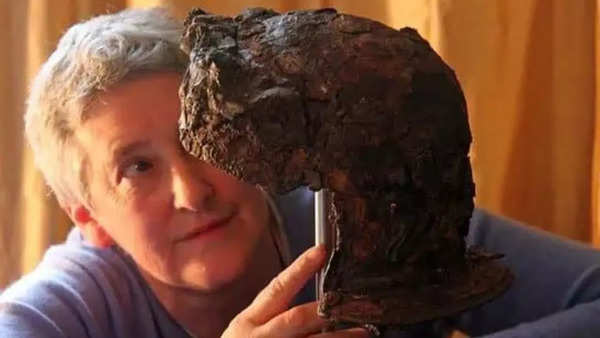The helmet, now known as the Hallaton Helmet, was unearthed in Leicestershire, England, alongside a hoard of coins and other Iron Age artifacts.Initially, its appearance was unremarkable, buried among pig bones and gold coins, suggesting its placement at a native British shrine. However, the true value of the helmet lay beneath the corrosion and soil.

The Hallaton Helmet before it was restored. It was often referred to as a ‘rusty bucket’. Source: British Museum
The Hallaton Helmet is believed to have belonged to a high-ranking Roman cavalry officer, dating back to around 43 B.C.E. Its design is ornate, featuring layers of iron and thin silver, adorned with gold leaf. The helmet is decorated with motifs of wreaths, lions, and the goddess Victory, and it even depicts a Briton cowering beneath the hooves of a Roman emperor’s horse—a detail that has sparked debate among scholars about the relationship between Romans and Britons during the conquest of Britain.
The restoration process was meticulous, spanning over two decades. Experts at the British Museum and Leicester University painstakingly reconstructed the helmet from its fragmented state. The conservation efforts were supported by donations, including a significant grant from the Heritage Lottery Fund, which allowed Leicester County Council to purchase the helmet for public display.
The helmet’s restoration has not only brought back to life a piece of history but also posed important questions for future research. Dr. Jeremy Hill of the British Museum suggests that the helmet’s presence and the manner of its burial indicate that local Britons may have fought alongside the Romans. This theory challenges the traditional narrative of the Roman conquest as a clear-cut conflict between the invaders and the native population.
Other scholars, however, consider the helmet to be a war trophy or a diplomatic gift, reflecting the complex interactions between the conquering Romans and the conquered Britons. Regardless of its original purpose, the helmet’s restoration has provided a tangible connection to the past, allowing modern viewers to glimpse the craftsmanship and artistry of a bygone era.
The Hallaton Helmet now resides at the Harborough Museum, where it pays tribute to the skill of ancient artisans and the lasting legacy of the Roman Empire in Britain. Its restoration has not only preserved a significant archaeological find but also reignited interest in the history of Roman Britain and its impact on the region’s cultural heritage.
The helmet’s journey from a corroded relic to a restored masterpiece is a reminder of the value of preserving history. It highlights the importance of archaeological endeavors and the need for continued support for such projects.
Did Samantha Ruth Prabhu avoid Naga Chaitanya during a recent event? Here’s what we know

